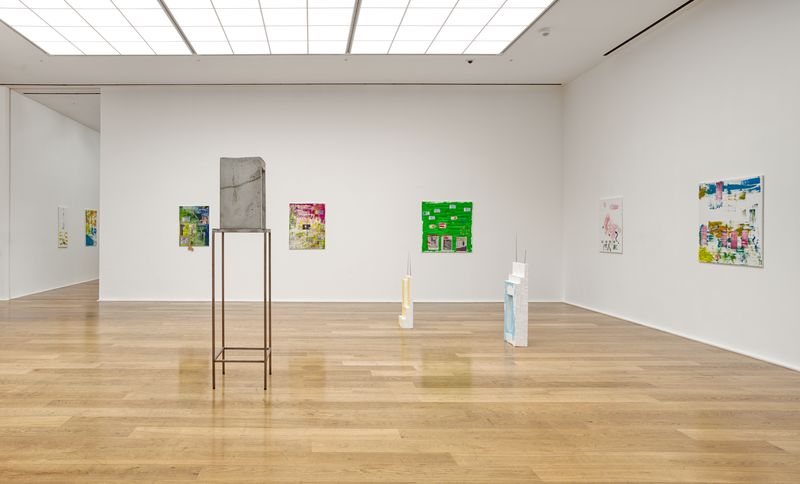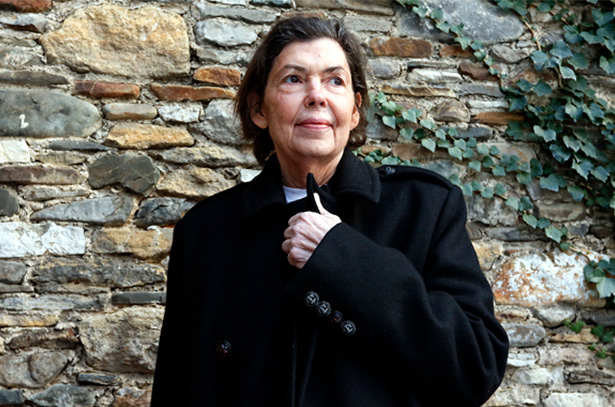
Isa Genzken
Geldbilder
26 March - 16 May 2015
London
In a new series of paintings unveiled at Hauser & Wirth London, Genzken employs motifs from the language of capitalism to explore themes of self- and social-examination. Since the 1970s, Genzken's diverse practice has encompassed sculpture, photography, found-object installation, drawing and painting. Her work borrows from the aesthetics of Minimalism, punk culture and assemblage art to confront the conditions of human experience in contemporary society and the uneasy social climate of capitalism. Although her approach varies greatly, Genzken has maintained a striking common thread and internal truth to both her vision and her works of art themselves.
In the Geldbilder works, Genzken takes money as a painterly medium itself, affixing notes and coins of various currencies and denominations to the canvas. She uses the very tools of a profit-driven society in her most direct and literal engagement with its principles. Genzken disassociates money from its role as currency, and encourages an appreciation of it as a material object, as a social artefact, and for its symbolic connotations. Genzken plays on the concept of art as investment, with the suggestion that these notes and coins might be removed and re-used in times of hardship. The paintings physically 'hold' capital, acting as stable assets even in the most volatile market. These poetic and chaotic paintings make explicit reference to the monetary value of art, and the systems that underpin society at large. Genzken has also incorporated money into her earlier, more abstract paintings of the 1990s, in which she laid coins onto a canvas and coated the surface with lacquer, before removing them to reveal only the imprint of the coins' shape left behind. Her three artist books entitled 'I Love New York, Crazy City' (2006) represent information overload, and the stimulation and urban pace of the city at a time in which she was working through her own unsettled emotions after a divorce. The books are comprised of layers of ephemeral papers such as newspaper clippings, receipts, photographs, cigarette packets, and include a number of $500 bills.
The new series possesses a raw, aggressive energy. Genzken has roughly covered each canvas in a combination of vivid, unmixed colours, using either a large-bristle brush or spray can, sometimes dripping the paint in thick, random gestures, with the impressions of the canvas' supports and areas of unmarked surface still visible. The coins and notes are applied in seemingly random patterns; stacked, grouped to create shapes or arranged in lines traversing the surface of the painting. Elsewhere she scrawls her name in large, graffiti-style letters in spray paint, as an outlandish version of the artist's signature and a reference to the autobiographical element that is ever-present throughout her practice. Exploring the dynamic of personal versus social anxiety, Genzken integrates photographs of herself amongst the material adorning the Geldbilder paintings, continuing her interest in representations of the body, and of herself in particular.
The Geldbilder paintings include found objects reappropriated for artistic use. An anthropologist of her own environment, Genzken incorporates aspects of her immediate surroundings into the artworks as a contextual reference point, including promotional leaflets for products and services in Berlin, where she lives and works. In the manner of Robert Rauschenberg's Combines, small plastic animals are glued to a painting's surface, or a feather, fabric pouch or wooden ruler in the shape of a toy gun are suspended from the bottom of the canvases. With the inclusion of these ubiquitous objects the works come to resemble tableaux of contemporary society. Genzken's ongoing interest in modernist architecture pervades her new body of work; as a reference point to the aesthetics of construction, Genzken applies striations of industrial tape to the surfaces of the paintings, and the shape of the canvases recall skyscrapers and building blocks.
The Geldbilder paintings are contextualised within the exhibition by earlier examples of Genzken's work, including a group of concrete sculptures from the early 1980s.
This exhibition coincides with a major presentation of new work by Genzken at MMK Museum für Moderne Kunst Frankfurt am Main, Frankfurt, Germany. In June, the Institute of Contemporary Arts, London, England will host an exhibition of Genzken's Basic Research paintings. Genzken will also present a compact survey as part of the 56th International Art Exhibition, Biennale di Venezia, Venice, Italy, curated by Okwui Enwezor.
About the Artist
Isa Genzken has long been considered one of Germany's most important and influential contemporary artists. Born in Bad Oldesloe, Germany, Genzken studied at the renowned Kunstakademie Düsseldorf whose faculty at the time included Joseph Beuys, Bernd and Hilla Becher, Benjamin H.D. Buchloh and Gerhard Richter. Genzken had her first major retrospective in 2009. 'Isa Genzken: Open Sesame!' opened at the Whitechapel Art Gallery, London, England (2009) and travelled to Museum Ludwig, Cologne, Germany (2009). Other important solo exhibitions include 'Hallelujah', Schinkel Pavillon, Berlin, Germany (2012); Museion Bozen, Bolzano, Italy (2010); 'Ground Zero', Hauser & Wirth London (2008); and Wiener Secession, Vienna, Austria (2006). In 2007, Genzken was chosen to represent her country in the 52nd Venice Biennale. Also in 2007, Genzken's works were featured for the third time in Skulptur Projekte Münster, Munster, Germany. Genzken's work has also been included in three Documenta exhibitions: documenta XI (2002); documenta IX (1992); and documenta VII (1982).
In 2013, a touring retrospective opened at MoMA Museum of Modern Art, New York NY and travelled to The Dallas Museum of Art, Dallas TX and the Museum of Contemporary Art, Chicago IL in 2014.
Selected images

Geldbild II
2014

Geldbild VI
2014

Geldbild IX
2014

Geldbild XV
2014

Geldbild XXV
2014

Geldbild XXI
2014

Geldbild XXXV
2014
Installation views


About the Artist

Isa Genzken
Isa Genzken has long been considered one of Germany’s most important and influential contemporary artists. Born in Bad Oldesloe, Germany, Genzken studied at the renowned Kunstakademie Düsseldorf whose faculty at the time included Joseph Beuys, Bernd and Hilla Becher, Benjamin H.D. Buchloh and Gerhard Richter. Since the 1970s, Genzken’s diverse practice has encompassed sculpture, photography, found-object installation, film, drawing and painting. Her work borrows from the aesthetics of Minimalism, punk culture and assemblage art to confront the conditions of human experience in contemporary society and the uneasy social climate of capitalism.Genzken is best known for her sculptures, gaining attention for her minimalist oriented Hyperbolos and Ellipsoids in the late 70s, and architecturally-inflected works such as her recent epoxy resin windows and skyscraper Columns from the 90s. Genzken’s practice is incredibly wide-ranging, but her work remains dedicated to challenging the viewer’s self-awareness by means of physically altering their perceptions, bringing bodies together in spaces and integrating elements of a mixed media into sculpture.
Genzken’s totemic columns, pedestal works and collages combine disparate aspects from her many sources in seemingly nonsensical, yet harmonious sculptural compilations. These sculptures take the form of precariously stacked assemblages of potted plant designer furniture, empty shipping crates and photographs, among other things, arranged with the traditions of modernist sculpture in mind. With this cacophonous array of objects, Genzken undermines the classical notions of sculpture, re-creating the architectural dimensions of her beloved skyscrapers and the riotous colors of the city streets. Devoid of the weightiness and overpowering scale seen in the sculptures of her Minimalist predecessors, her work abandons notions of order and power, allowing the viewer to relate to the works’ inherently human qualities of fragility and vulnerability.
Inspired by the stark severity of modernist architecture and the chaotic energy of the city, Genzken’s work is continuously looking around itself, translating into three-dimensional form the way that art, architecture, design and media affects the experience of urban life, and the divides between public and private. There is an intuitive and consistent manner to Genzken’s work, not only in dramatising aspects of space and scale for the audience, but in creating new dialogues and contact with surfaces of material. The socio-political content is evident and central to her oeuvre.
In 2017, Genzken was awarded the prestigious Goslarer Kaiserring (or Emperor’s Ring) by the city of Goslar, Germany.
Current Exhibitions
1 / 12


















